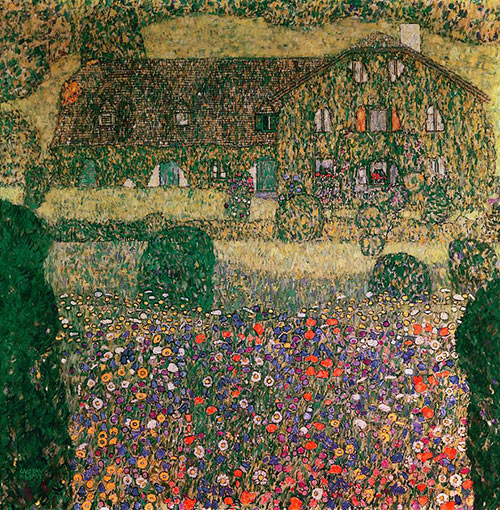Upon visiting the countryside during the summer with his lover, Gustav Klimt painted an array of pieces that encompassed the countryside.
The artist had visited Lake Attersee, which is a prominent inspiration within his work, including The Church in Unterach on Attersee (1901) and Attersee (1900).
The painting exposes a country house secluded within a hill near a meadow of flowers. The style of the piece remains through an impressionism mosaic style, accentuating the minor details through beautiful patterns.
The traditional Austrian countryside house holds elements of English architecture, similarly styled to a barn. The house is located at the bottom of a salad coloured hill, which runs above the mountain. The walls of the house are based on wide shades of green, from light salad to dark lush greens.
The house is covered in green vines that grow on the exterior of the house. Beautiful windows cover the side of the house, with the middle one with classic French folding windows in a bright orange colour. The remainder of the house is covered in dark tiles, similarly patterned to the style of a barn.
Klimt was able to incorporate a landscaped angle to the piece, elongating the frame to manifest the large hills and meadows of flowers. The focal point of the painting is illustrated through the large meadow located at the front of the piece. Flowers flow amongst the plain of land, in bright shades of red, orange, pink, purple, blue and white. These rich shades add a fairy tale like presence to the house, uprising the question of whether the painting is a representation of a house Klimt came across during his summer trip, or is a glimpse of his imagination.
Dark green scrubs fill the landscape around the house, bringing attention to the tall shrubs located around the piece. These shrubs are blended into the background as light green grass covers the fields of the landscape. The classic green palette that Klimt uses within his work symbolizes the rich environment at the time of the 19th century. The bright green colours caught the eye of the artist, as his city life was seized by a rich transition of prominent architecture and concrete that filled the streets.
Klimt's fascination with a wide array of flowers is inspired by a mosaic style, strategically placed in a pattern to accentuate one another. A classic theme within the artist's work is the trademark flowers filled with a yellow centre displayed across the meadow. The vertical brush strokes within the painting add the intensity of depth within the piece. However, the upper trees within the piece cover the element of a sky taking away from an detailed landscape.
The emotion within the painting remains positive and welcoming, as the viewer wishes to visit the illuminating property that Klimt paints, wondering if perhaps that country house is the one the artist stayed at.
The rich colours throughout the work illustrate Gustav Klimt's impressionism trademark that showcases a dense widespread of flowers. The red and blue blossoms that fill the piece, add a contrast to the greens that fill the canvas. Klimt's work has transcended through multiple styles and decades, illustrating a classic painter who remains a prominent artist in the 19th century.




